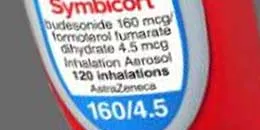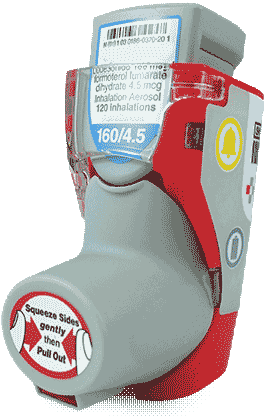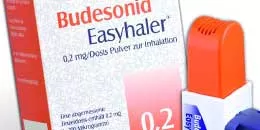Buy Symbicort 160/4.5

Symbicort
- Type: Control
- Manufacturer: AstraZeneca
- Substance: Budesonide + Formoterol
- Dosage: 100/6, 160/4.5, 200/6, 400/6
- Avg Price: $359
Is it true that Symbicort is a steroid medication?
The drug Symbicort is an inhaling drug that includes the components such as formoterol fumarate dihydrate and budesonide. This medication is the ratio of a bronchodilator and a steroid medicine. The drug Symbicort is a long-acting steroid medication. It is applied in order to suppress the risk of possible bronchospasm among the patients suffering from COPD and asthma.
Can Symbicort be applied among patients with severe asthma?
Symbicort medication is often prescribed to people, who experience moderate or severe uncontrolled asthma. This inhaler is combined, as it includes two medicines: the long-acting bronchodilator formoterol and the corticosteroid agent budesonide. Symbicort should be taken in order to suppress bronchospasm, even if the patient constantly has inhalations with the help of any other corticosteroid drug inhalers.
Does Simbicort have an anti-inflammatory effect?
The Symbicort inhalation device combines two medications in one inhaler. They include a corticosteroid drug budesonide and a long-acting bronchodilator formoterol. Budesonide is an anti-inflammatory agent. It is formoterol that is responsible for the expansion of the bronchi and the rapid flow of the medication substance into the lungs, which contributes to the rapid action and the suppression of the inflammation and the reduction or prevention of a bronchospasm.
What are the alternatives to Symbicort?
The inhaler Symbicort is most often compared with the inhalation medicine Advair, as it, like Symbicort, includes a corticosteroid agent and a fast-acting bronchodilator. Advair contains fluticasone and salmeterol. As for other medications, then the medications Dulera and Breo can also be alternatives to the Symbicort inhaler.
Does Symbicort inhaler have the properties of steroids?
The Symbicort inhalers are metered-dose inhalers that are applied among the patients over 12 years of age for the treatment of asthma and the patients over 18 years of age for the treatment of COPD among adults. It includes two components: formoterol and budesonide. Symbicort can be called a steroid medication, since its component budesonide is a corticosteroid agent and it has anti-inflammatory properties, while formoterol promotes the expansion of the airways.
Do I need to inhale Symbicort constantly?
The Symbicort inhaler can be prescribed both as a maintenance medication and as a rapid-acting inhaler during health deterioration and the suppression of bronchospasm. Usually, the daily dosage of the medication to maintain a stable health state is minimal and is set by the healthcare provider depending on the severity of the disease.
Is it allowed to drink any liquid after using the Symbicort inhaler?
During the period of using the Symbicort inhaler, after the inhaling of the drug, the medication helps to expand the airways and reduce the inflammation. After the inhalation, it is recommended to rinse your mouth with a small amount of water without swallowing it. After rinsing your mouth it is necessary to spit out the water immediately. For some time after the inhalation, it is not recommended to drink water or any other liquids, as this may interfere with the action of the medication.
How long does it take for Symbicort to start working?
Symbicort is a fast-acting inhaler used among people suffering from asthma and COPD. In the case of a bronchospasm, the components of the drug begin to act usually within 15-20 minutes after the inhalation of the medication. If you are using Symbicort as a maintenance therapy, your symptoms may not improve in about 2 weeks after you start using this inhaler. If COPD is chronic, then the symptoms may improve in 5 minutes after the inhalation.
Will Symbicort help with a cough?
The inhaler Symbicort is often prescribed to the patients with the symptoms of asthma or COPD, which include shortness of breath, problems with breathing, chest tightness, and coughing. This medication opens the airways and suppresses the inflammation, and also treats cough, and other asthma and COPD symptoms.
Which inhaler is more effective: Symbicort or Ventolin?
Both drugs, Symbicort and Ventolin, are often prescribed to people with asthma and COPD. However, the choice of a suitable inhaler depends on the severity of the disease and the symptoms, experienced by the patient.
Ventolin is usually prescribed as a life-saving drug that works extremely fast. Symbicort is not a life-saving medication as it takes some time to start working, but it is often used to control and maintain asthma symptoms over a long period of time. Both inhalers perform their functions quite effectively. Thus, the choice of an inhaler depends on the purpose, for which you need to use it.
What will happen if I suddenly finish using the Symbicort inhaler?
The application of Symbicort should not be abruptly discontinued as this may lead to the occurrence of some unwanted negative symptoms such as dizziness, weakness, muscle pain and nausea. If taking the drug has to be finished, then you should contact your doctor, who will gradually reduce the recommended dosage until it is completely discontinued.
What medication is the most effective for treating COPD symptoms?
Chronic obstructive pulmonary disease requires a maintenance therapy and the use of special inhaler. One of the most commonly prescribed medications for COPD is the drug Advair. It contains the following components: the bronchodilator salmeterol and the corticosteroid fluticasone. This inhaler should be used for a long time, usually two inhalations a day, as the maintenance treatment.
What is the difference between Advair and Symbicort?
Advair and Symbicort are two inhalers often used for treating asthma and COPD. Both of these inhalers contain the following drugs in their composition: a long-acting beta2-adrenergic agonist and a corticosteroid, which helps to suppress the inflammatory process. The difference between the two drugs is that Advair contains budesonide as a corticosteroid, while Symbicort contains another drug, fluticasone.
Is Symbicort inhaler safe?
The Symbicort inhaler is one of the most commonly prescribed medications for treating the symptoms of asthma and COPD. According to the studies, this inhaler is safe even for elderly patients. One of the recommendations of the FDA, concerning taking the drug Symbicort, is that the patients with heart diseases should constantly be controlled by their healthcare provider.
Is it true that one of the side effects of Symbicort is a “moon” face?
Taking the inhaler Symbicort may cause some side effects, which include the following health conditions: headache, cough, tachycardia, hoarseness, muscle cramps. With an increase of the amount of corticosteroid drugs in the human’s body, the following adverse reactions may appear: severe sweating, bruising, muscle pain, bruising and the so-called "moon" face.
Can I suddenly stop using Symbicort?
You must follow all of your doctor's instructions while taking Symbicort. Never increase the prescribed dosage on your own. If you decided to stop taking the medicine, then you should first consult your doctor. Abrupt discontinuation of this medicine will cause the developing of the withdrawal symptoms, which are unwanted side effects. To avoid them, you should gradually reduce the daily dosage of the medication until it is completely canceled.
What is the duration of the Symbicort action?
Like the majority of inhalers the drug Symbicort has one-year action duration. The manufacturer does not guarantee the positive effect of the medication if you take the inhaler for more than the indicated acceptable period of use, so you should take it into consideration if your medicine has expired but you continue using it.
Is it possible to combine the medicines Symbicort and Ventolin?
Patients suffering from asthma or COPD have to take an inhaler as maintenance therapy. However, even if you regularly use your Symbicort inhaler, it is recommended to constantly carry a rescue inhaler with you at all times. Thus, if you have been prescribed Symbicort or Advair, then you may be recommended to carry Ventolin inhaler as a rescue inhaler.
Is it true that Symbicort inhaler should not be used in combination with albuterol?
One of the components of Symbicort is formoterol. When combined with certain medicines, formoterol can have a bad interaction and it may cause unwanted reactions. Albuterol is one of such drugs. Formoterol and albuterol interactions may cause an increase in cardiovascular adverse reactions, which include dysrhythmias and problems with arterial pressure and heart rhythm. If you have been prescribed Symbicort, then you should inform your doctor about all the medicines that you usually take.
Is anxiety one of the adverse effects of Symbicort?
Common side reactions of Symbicort are headache, diarrhea, nasal congestion, hoarseness, stomach problems, nausea, throat irritation, and muscle pain. Some cases have been noted, in which patients have experienced anxiety as a side symptom, although this is a very rare reaction. If you begin to experience anxiety or any other negative symptoms after using the Symbicort inhaler, then you should inform your doctor immediately.
Do I need to rinse my mouth when using an inhaler?
A possible side effect after using the inhaler may be irritation of the throat. To prevent this condition, it is recommended after each use of the inhaler to rinse your mouth with water for a few seconds and then spit out the water. It also helps to prevent the development of an infection.
Do I need to use a spacer while taking Symbicort?
The application of the inhaler Symbicort is carried out with the help of a spacer or without it. The process of inhaling the drug is more successful with a spacer. The spacer helps the medication to get to the lungs faster and easier. If you choose to take Symbicort without using a spacer, then you may have some difficulties in administering the medication, as the absence of a spacer requires more coordination.
Does Symbicort come as a dry powder form?
The inhalation steroid drug Symbicort is a long-acting inhaler that contains the medication, which is produced in a form of a dry powder for inhaling it. As a result of inhaling the medication, the drug powder that consists of formoterol and budesonide penetrates into the human’s lungs, expands the airways and reduces the inflammation.
Formoterol
Formoterol is a selective β2-adrenoreceptor agonist that, when inhaled, leads to a rapid and prolonged relaxation of the smooth muscles of the bronchi in patients with reversible airway obstruction.
Bronchodilating effect is dose-dependent, the drug begins to act for 1-3 min. The duration of action is not less than 12 hours after a single dose.
Clinical Efficacy And Safety
Clinical studies in adult patients have shown that the addition of formoterol to budesonide alleviates the symptoms of asthma, improves lung function and reduces the frequency of exacerbations.
The use of budesonide / formoterol for maintenance therapy and to alleviate symptoms provided a statistically and clinically significant reduction in the incidence of severe exacerbations of asthma when compared with other therapies. In studies with patients who required medical attention in connection with the presence of acute asthma symptoms, the use of budesonide / formoterol provided a quick and effective relief of bronchospasm symptoms similar to salbutamol and formoterol.
Inhaled formoterol is rapidly absorbed. The maximum plasma concentration is reached within 10 minutes after inhalation. In studies, the average distribution in the lungs of formoterol after inhalation through a powder inhaler ranged from 28 to 49% of the dose received. Systemic bioavailability is about 61% of the dose received.
Symbicort Indications
Symbicort Turbuhaler is prescribed for adults and children aged 6 years for regular treatment of asthma in case of appropriate combination therapy.
Symbicort is prescribed for patients whose condition is not adequately controlled by inhaled corticosteroids and fast acting β2-adrenergic receptor agonists, if necessary, or for patients who are properly controlled by inhaled GCS and long-acting β2-adrenergic agonists.
Generic Symbicort
The answer to the question "Is over the counter Symbicort available?" - is No. But, there are some "features". You can buy generic version of Symbicort at online pharmacy. It contains the same main substance as the brand Symbicort, it costs cheaper, and, the last but not the least - it is not needed to have valid prescription to buy Generic Symbicort online.
Symbicort Dosage
Symbicort is not prescribed for initial treatment of asthma. Doses of Symbicort components are selected individually, and they must be adjusted in accordance with the severity of the disease. This should be taken into account not only at the beginning of the use of combined preparations, but also in the correction of the maintenance dose. If a combination of doses other than those in a combined inhaler is required, appropriate doses of β2-adrenergic agonists and / or corticosteroids in separate inhalers should be given.
The dose should be titrated to the minimum dose, which allows you to effectively control the symptoms of the disease. Patients should regularly undergo repeated examinations with a doctor who prescribes the drug, so that the dose of Symbicort remains optimal. After achieving a long-term control of symptoms with the minimum recommended dose, you should try to control symptoms only with the help of an inhaled GCS.
There are two options for using Symbicort OTC.
- For maintenance therapy. Symbicort is used for regular maintenance therapy in combination with a separate fast acting bronchodilator, used as an emergency.
- For maintenance therapy and relief of symptoms. Symbicort is used for regular maintenance therapy, as well as if necessary - to relieve symptoms.
Use Symbicort for maintenance therapy
Patients should be advised to always carry a separate high-speed bronchodilator for use as an emergency.
Recommended doses: Adults (from 18 years old): 1-2 inhalations 2 times a day; for a dosage of 320 mcg / dose + 9 mcg / dose - 1 inhalation 2 times a day. Some patients may require up to 4 inhalations twice a day (for a dosage of 320 mcg / dose + 9 mcg / dose - up to 2 inhalations 2 times a day).
Adolescents (aged 12-17 years): 1-2 inhalations 2 times a day; for a dosage of 320 mcg / dose + 9 mcg / dose - 1 inhalation 2 times a day.
Children (aged 6 years): 2 inhalations 2 times a day. For use in children aged 6-11 years, there is a dosage form of 80 mg / dose + 4.5 μg / dose.
Usually after achieving control over the symptoms of the disease with the drug 2 times a day, the dose is titrated to the minimum effective dose, up to the application of Symbicort 1 time per day, in cases when, in the opinion of the doctor, the patient needs maintenance therapy in combination with a long-acting bronchodilator .
More frequent use of an additional high-speed bronchodilator indicates a worsening of the patient's condition and the need to review the treatment of asthma.
Use Symbicort For Maintenance Therapy And Relief Of Symptoms
Take a daily maintenance dose of Symbicort, and in addition to apply Symbicort in case of relief of symptoms. Patients should always be advised to have Symbicort along with them for immediate use.
Patients who often and in large quantities apply Symbicort inhalations, if necessary, should be carefully monitored regarding the development of dose-related adverse events.
Recommended doses. For maintenance therapy and symptom relief with Symbicort, dosage forms are used (160 μg / 4.5 μg / dose and 80 μg / 4.5 μg / dose). Adults (at the age of 18 years) the recommended maintenance dose is 2 inhalations per day - 1 inhalation in the morning and evening or 2 inhalations only in the morning or only in the evening. If necessary, use 1 additional inhalation for symptoms. If symptoms persist after a few minutes, additional inhalation should be given. In any particular case, do not use more than 6 inhalations.
Usually a total of not more than 8 inhalations are required per day; however, for a limited period, the total daily dose may be up to 12 inhalations. Patients who take more than 8 inhalations per day are strongly advised to consult a doctor. They need to undergo a second examination and review supportive therapy.
Children and adolescents under the age of 18: children and adolescents are not recommended to use Symbicort for maintenance therapy and relief of symptoms.
Side Effects
Since Symbicort contains budesonide and formoterol, there may be side effects that develop when using each of the compounds separately. Simultaneous use of both substances did not increase the incidence of adverse reactions. The most common adverse reactions are the pharmacologically expected effects of β2-adrenergic agonists, such as tremor and palpitation. They are usually weak and go through several days of treatment.
- Candidiasis of the mouth and throat
- Headache, tremor
- Increased heart rate
- Minor irritation in the throat, cough, hoarseness
Candidiasis of the oropharynx is the result of sedimentation of the drug in the oral cavity. It is recommended that the patient be instructed to rinse the mouth with water after each inhalation of a maintenance dose in order to minimize the risk of developing oral candidiasis.
Special Instructions
If it is necessary to stop treatment it is recommended to gradually reduce the dose, rather than abruptly cancel therapy.
If, in the patient's opinion, treatment is ineffective, or if the maximum daily dose of Symbicort is exceeded, the patient should be strongly advised to consult a doctor
Patients should be reminded of the need to continue the supportive use of Symbicort in accordance with prescription, even in the absence of symptoms.
Symbicort Therapy should not be started during a period of exacerbation of asthma, acute manifestation or significant deterioration of its course.
Comparison
- Symbicort vs Fluticasone
- Symbicort vs Serevent
- Symbicort vs Ventolin
- Symbicort vs Combivent
- Symbicort vs Xopenex
- Symbicort vs Breo
- Symbicort vs Pulmicort
- Symbicort vs Dulera
- Symbicort vs Alvesco
- Symbicort vs Flovent
- Symbicort vs Formoterol
- Symbicort vs Beclomethasone
- Symbicort vs Salmeterol
- Symbicort vs Vilanterol
- Symbicort vs Mometasone



